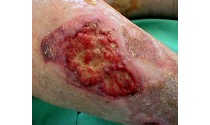Introduction:
In the intricate world of wound care management, unexpected challenges can arise, requiring medical providers to adapt and innovate. This captivating case study involves a mid-70s patient with a long-standing open wound on her lateral right thigh, revealing unexpected twists that ultimately led to a diagnosis of squamous cell carcinoma.
Case Background:
The patient had lived with this wound since her teenage years, seeking treatment from various practitioners with limited success. Biopsies consistently pointed to plaque psoriasis, and the patient, not on disease-modifying treatments, relied on basic gauze bandages. Initial treatment in an advanced wound healing center using a moist antimicrobial and anti-inflammatory dressing yielded significant progress, reducing the wound size by 90% in about 6-8 weeks.
Unexpected Turn of Events:
Despite the initial success, the wound’s quality and appearance changed, and it started increasing in size. Recognizing the anomaly, a repeat biopsy was conducted, unveiling the unexpected – squamous cell carcinoma. This is a classic description of a Marjolin’s Ulcer. This case emphasizes the importance of vigilance when dealing with chronic wounds that deviate from the expected response to therapy.
Management and Resolution:
Prompt action was taken, involving surgical excision until clean margins were achieved. The wound was diligently treated until the base was covered in healthy granulation tissue, followed by a successful split-thickness skin graft. The patient healed completely, free from cancer-related complications or the recurrence of the chronic wound.
Key Lessons Learned:
- **Prolonged Inflammatory Processes Demand Vigilance:**
Long-standing inflammatory wounds, unresponsive to standard therapy, should raise suspicion for potential malignant transformation. Medical providers should consider repeat biopsies, even if prior results suggested non-malignant conditions.
- **Adapting Treatment Approaches:**
The dynamic nature of chronic wounds requires continuous assessment and adaptation of treatment plans. Swift recognition of changes in the wound’s response is crucial for effective management.
- **Multidisciplinary Collaboration:**
This case underscores the significance of collaboration between wound care specialists, pathologists, and surgical teams. A holistic approach is vital in managing complex cases that may involve unexpected diagnoses.
Conclusion:
In the realm of wound care, the unexpected can and does occur. This case study serves as a reminder to medical providers managing chronic wounds – a keen eye for changes in response, timely biopsies, and a multidisciplinary approach are indispensable. By sharing knowledge and experiences, we enhance our ability to navigate the complexities of wound care, ultimately improving patient outcomes.


